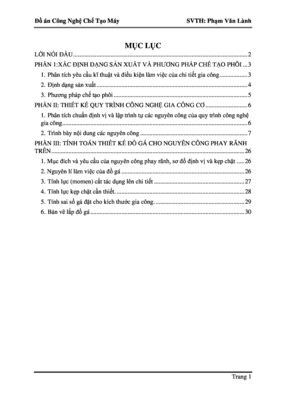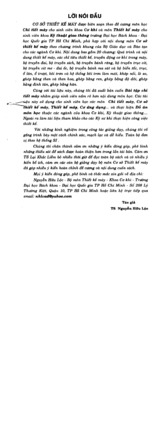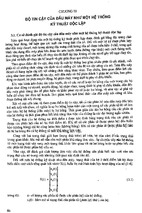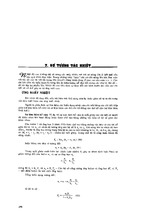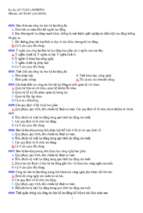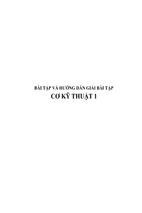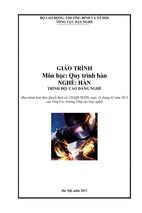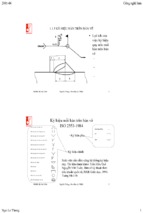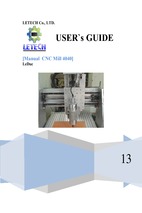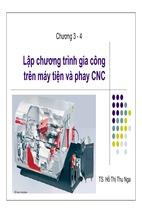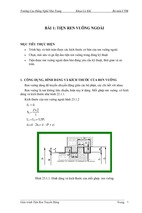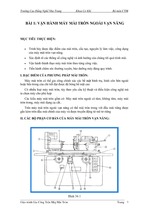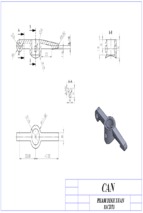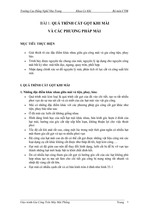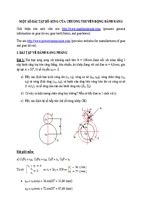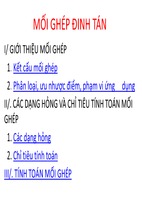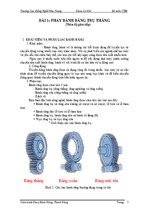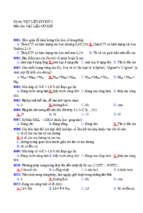Dynamic Systems and Control, Chapter 1: Mathematical Models of Systems
Mathematical Models of Systems
© 2015 Quoc Chi Nguyen, Head of Control & Automation Laboratory,
[email protected]
0-1
Dynamic Systems and Control, Chapter 1: Mathematical Models of Systems
Dynamics of systems
• Dynamics describes how the states evolves, as a function on the
current state and any external inputs
• Inputs describe the external excitation of the dynamics
• Outputs describe the directly measured variables
Outputs are a function of the state and inputs ⇒ not
independent variables
Not all states are outputs; some states can’t be directly
measured
© 2015 Quoc Chi Nguyen, Head of Control & Automation Laboratory,
[email protected]
0-2
Dynamic Systems and Control, Chapter 1: Mathematical Models of Systems
Dynamics of Mechanical Systems
© 2015 Quoc Chi Nguyen, Head of Control & Automation Laboratory,
[email protected]
0-3
Dynamic Systems and Control, Chapter 1: Mathematical Models of Systems
Dynamics of Mechanical Systems
© 2015 Quoc Chi Nguyen, Head of Control & Automation Laboratory,
[email protected]
0-4
Dynamic Systems and Control, Chapter 1: Mathematical Models of Systems
Dynamics of Electrical Systems
© 2015 Quoc Chi Nguyen, Head of Control & Automation Laboratory,
[email protected]
0-5
Dynamic Systems and Control, Chapter 1: Mathematical Models of Systems
Dynamics of Thermal Systems
Derive dynamic equation of the tank
C: Thermal capacitance
hi: Heat rate of input
ho:
: Change of temperature
© 2015 Quoc Chi Nguyen, Head of Control & Automation Laboratory,
[email protected]
0-6
Dynamic Systems and Control, Chapter 1: Mathematical Models of Systems
What is your observation?
• The dynamics of many systems, whether they are mechanical,
electrical, thermal, and so on, may be described in terms of
differential equations.
• The differential equations may be obtained by using physical
laws governing a particular system (e.g., Newton’s laws for
mechanical systems and Kirchhoff’s laws for electrical
systems).
• Deriving reasonable mathematical models is the most
important part of the entire analysis of control systems
© 2015 Quoc Chi Nguyen, Head of Control & Automation Laboratory,
[email protected]
0-7
Dynamic Systems and Control, Chapter 1: Mathematical Models of Systems
System modeling
Models are a mathematical representations
of system dynamics:
• Models allow the dynamics to be
simulated and analyzed, without having
to build the system
• Models are never exact, but they can be
predictive
The model you use depends on the questions
you want to answer
• A single system may have many models
• Time and spatial scale must be chosen to
suit the questions you want to answer
• Always formulate questions before building
a model
© 2015 Quoc Chi Nguyen, Head of Control & Automation Laboratory,
[email protected]
0-8
Dynamic Systems and Control, Chapter 1: Mathematical Models of Systems
The principle of causality
The current output of the system (the output at time t = 0)
depends on the past input (the input for t<0) but does not
depend on the future input (the input for t>0).
Examples of causal systems
- Memoryless system:
∝
- Autoregressive filter:
Examples of noncausal systems
- Central moving average:
-
Time reversal:
© 2015 Quoc Chi Nguyen, Head of Control & Automation Laboratory,
[email protected]
0-9
Dynamic Systems and Control, Chapter 1: Mathematical Models of Systems
Linear systems
A system is called linear if the principle of superposition applies
Given : → then
Linear time invariant
system (LTI)
The coefficients are constants or
functions only of the
independent variable
Linear timevarying system
(LTV)
The coefficients are
functions of time:
Ex: Spacecraft control system.
(The mass of a spacecraft
changes due to fuel
consumption)
© 2015 Quoc Chi Nguyen, Head of Control & Automation Laboratory,
[email protected]
0-10
Dynamic Systems and Control, Chapter 1: Mathematical Models of Systems
Transfer Function and Impulse Response Function
Definition. The transfer function of a linear, time-invariant,
differential equation system is defined as the ratio of the Laplace
transform of the output (response function) to the Laplace transform
of the input (driving function) under the assumption that all initial
conditions are zero.
Differential equation
© 2015 Quoc Chi Nguyen, Head of Control & Automation Laboratory,
[email protected]
0-11
Dynamic Systems and Control, Chapter 1: Mathematical Models of Systems
Transfer Function and Impulse Response Function
- The transfer function is a property of a system itself, independent of the
magnitude and nature of the input or driving function.
- The transfer function does not provide any information concerning the
physical structure of the system.
Differential equation
© 2015 Quoc Chi Nguyen, Head of Control & Automation Laboratory,
[email protected]
0-12
Dynamic Systems and Control, Chapter 1: Mathematical Models of Systems
Laplace Transform
- Laplace transform: A transformation from t (time)
to s (Laplace variable)
Pierre Simon
Laplace
- Definition: Laplace transformation . is used to map time
domain function into domain function
.
- This mapping . :
is defined as
→
© 2015 Quoc Chi Nguyen, Head of Control & Automation Laboratory,
[email protected]
0-13
Dynamic Systems and Control, Chapter 1: Mathematical Models of Systems
List of Common Transforms
© 2015 Quoc Chi Nguyen, Head of Control & Automation Laboratory,
[email protected]
0-14
Dynamic Systems and Control, Chapter 1: Mathematical Models of Systems
Taking a Laplace transform:
Transfer function
© 2015 Quoc Chi Nguyen, Head of Control & Automation Laboratory,
[email protected]
0-15
Dynamic Systems and Control, Chapter 1: Mathematical Models of Systems
© 2015 Quoc Chi Nguyen, Head of Control & Automation Laboratory,
[email protected]
0-16
Dynamic Systems and Control, Chapter 1: Mathematical Models of Systems
Dynamics of Electrical Systems
Taking a Laplace transform
11
11
Transfer function
1
1
© 2015 Quoc Chi Nguyen, Head of Control & Automation Laboratory,
[email protected]
0-17
Dynamic Systems and Control, Chapter 1: Mathematical Models of Systems
Derive dynamic equation of the tank
Rewrite dynamic equation
↔
;C
;
C: Thermal capacitance
hi: Heat rate of input
ho: Heat rate of output
: Change of temperature
R: Thermal resistance
c: Specific heat of liquid
M: Mass of liquid
Transfer function:
© 2015 Quoc Chi Nguyen, Head of Control & Automation Laboratory,
[email protected]
1
0-18
Dynamic Systems and Control, Chapter 1: Mathematical Models of Systems
How to find the output in time domain?
The output Y(s) can be written as the product of G(s) and X(s)
Taking an inverse Laplace transform gives the following convolution
integral:
If the input is an impulse
Complete information of the system (the dynamic characteristics of the
system) can be obtained by exciting it with an impulse input and measuring
the response.
© 2015 Quoc Chi Nguyen, Head of Control & Automation Laboratory,
[email protected]
0-19
Dynamic Systems and Control, Chapter 1: Mathematical Models of Systems
Matlab for Dynamic Systems and Control
© 2015 Quoc Chi Nguyen, Head of Control & Automation Laboratory,
[email protected]
0-20


